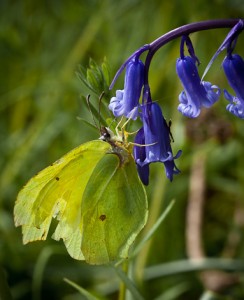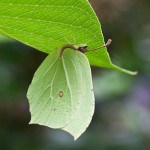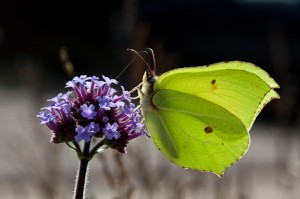One of the first butterflies that you will notice as the days get a bit warmer and lighter is the Brimstone. As its name suggests this is a yellow butterfly, which it is thought was the original butter-coloured fly from which butterfly was derived – its name later being changed to reflect its sulphurous colour.
The Brimstone is one of the few UK butterflies that overwinter as an adult and therefore it is one of the early fliers in Spring. In fact Brimstones were spotted on 2nd January in Hampshire and Surrey, and have already been spotted in Northamptonshire in February.
 Whilst many butterflies live as adults for only a few weeks Brimstones are a much longer-lived insect and, despite laying eggs only once a year, can be seen from February through to November, depending on where you are in the country. The best time to see the butterflies are reported to be April, May and August (the latter when the year’s eggs have gone through their full cycle and the adults have emerged). However, I think they are much more noticeable in March when there are fewer insects about and the bright yellow of their wings becomes very noticeable as it catches the spring sunshine. They are another of the indicator species that I use to decide that spring has finally sprung.
Whilst many butterflies live as adults for only a few weeks Brimstones are a much longer-lived insect and, despite laying eggs only once a year, can be seen from February through to November, depending on where you are in the country. The best time to see the butterflies are reported to be April, May and August (the latter when the year’s eggs have gone through their full cycle and the adults have emerged). However, I think they are much more noticeable in March when there are fewer insects about and the bright yellow of their wings becomes very noticeable as it catches the spring sunshine. They are another of the indicator species that I use to decide that spring has finally sprung.
So, how do you recognise a Brimstone butterfly and where will you see one? The males are a bright yellow colour whereas the females are much paler but both have an orange spot on their wings; their colour makes them unmistakeable in flight. They are a medium sized butterfly, their wings are about 2 1/4 inches and they are very strong fliers, often roaming away from their food sources in search of a mate.
 At rest you will notice that their wings are a beautiful leaf or shield shape. This helps them camouflage themselves for roosting overnight under ivy leaves or for when hibernating over winter. I was actually surprised by how well they blend in when I watched one move underneath the leaf of a dogwood in the garden to shelter from the rain.
At rest you will notice that their wings are a beautiful leaf or shield shape. This helps them camouflage themselves for roosting overnight under ivy leaves or for when hibernating over winter. I was actually surprised by how well they blend in when I watched one move underneath the leaf of a dogwood in the garden to shelter from the rain.
Brimstone caterpillars eat mainly buckthorn and alder buckthorn plants, they are bright green and apparently resemble the caterpillars of the cabbage white butterflies. I haven’t seen any yet, but I will let you know if I find some.
They are found almost anywhere there is a bit of sunshine. Males can be seen patrolling along hedgerows and roadside looking for love, whereas the females tend to be a little less obvious and hide in the vegetation. They are particularly fond of purple and nectar rich plants. In the spring you will often see them on primroses, cowslips and bluebells, whereas in the summer knapweed, teasel (which their long proboscis allows them to feed on) and thistles are popular. The Brimstones that I have seen in my garden tend to like the buddleia and verbena- as do most of the other insects.
So, in the coming month, keep an eye out for this remarkably pretty butterfly. If you see it, you will know spring is on its way.
If you want to know more about butterflies or help conserve them then the Butterfly Conservation website is a good place to start.
